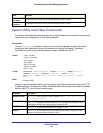
Utility Commands
547
ProSafe M4100 and M7100 Managed Switches
The following are examples of the CLI command.
traceroute Success:
(Switch) # traceroute 10.240.10.115 initTtl 1 maxTtl 4 maxFail 0 interval 1 count 3 port
33434 size 43
Traceroute to 10.240.10.115 ,4 hops max 43 byte packets:
1 10.240.4.1 708 msec 41 msec 11 msec
2 10.240.10.115 0 msec 0 msec 0 msec
Hop Count = 1 Last TTL = 2 Test attempt = 6 Test Success = 6
traceroute Failure:
(Switch) # traceroute 10.40.1.1 initTtl 1 maxFail 0 interval 1 count 3
port 33434 size 43
Traceroute to 10.40.1.1 ,30 hops max 43 byte packets:
1 10.240.4.1 19 msec 18 msec 9 msec
2 10.240.1.252 0 msec 0 msec 1 msec
3 172.31.0.9 277 msec 276 msec 277 msec
4 10.254.1.1 289 msec 327 msec 282 msec
5 10.254.21.2 287 msec 293 msec 296 msec
6 192.168.76.2 290 msec 291 msec 289 msec
7 0.0.0.0 0 msec *
Hop Count = 6 Last TTL = 7 Test attempt = 19 Test Success = 18
traceroute ipv6
Use the traceroute command to discover the routes that packets actually take when
traveling to their destination through the network on a hop-by-hop basis. The
<ipv6-address|hostname> parameter must be a valid IPv6 address or hostname. The
optional <port> parameter is the UDP port used as the destination of packets sent as part
interval
Use interval to specify the time between probes, in seconds. Range is 1–60
seconds.
count
Use the optional count parameter to specify the number of probes to send for each
TTL value. Range is 1–10 probes.
port
Use the optional port parameter to specify destination UDP port of the probe. This
should be an unused port on the remote destination system. Range is 1–65,535.
size
Use the optional size parameter to specify the size, in bytes, of the payload of the
Echo Requests sent. Range is 0–65507 bytes.
source
Use the optional source parameter to specify the source IP address or interface for
the traceroute.
Parameter Description


















